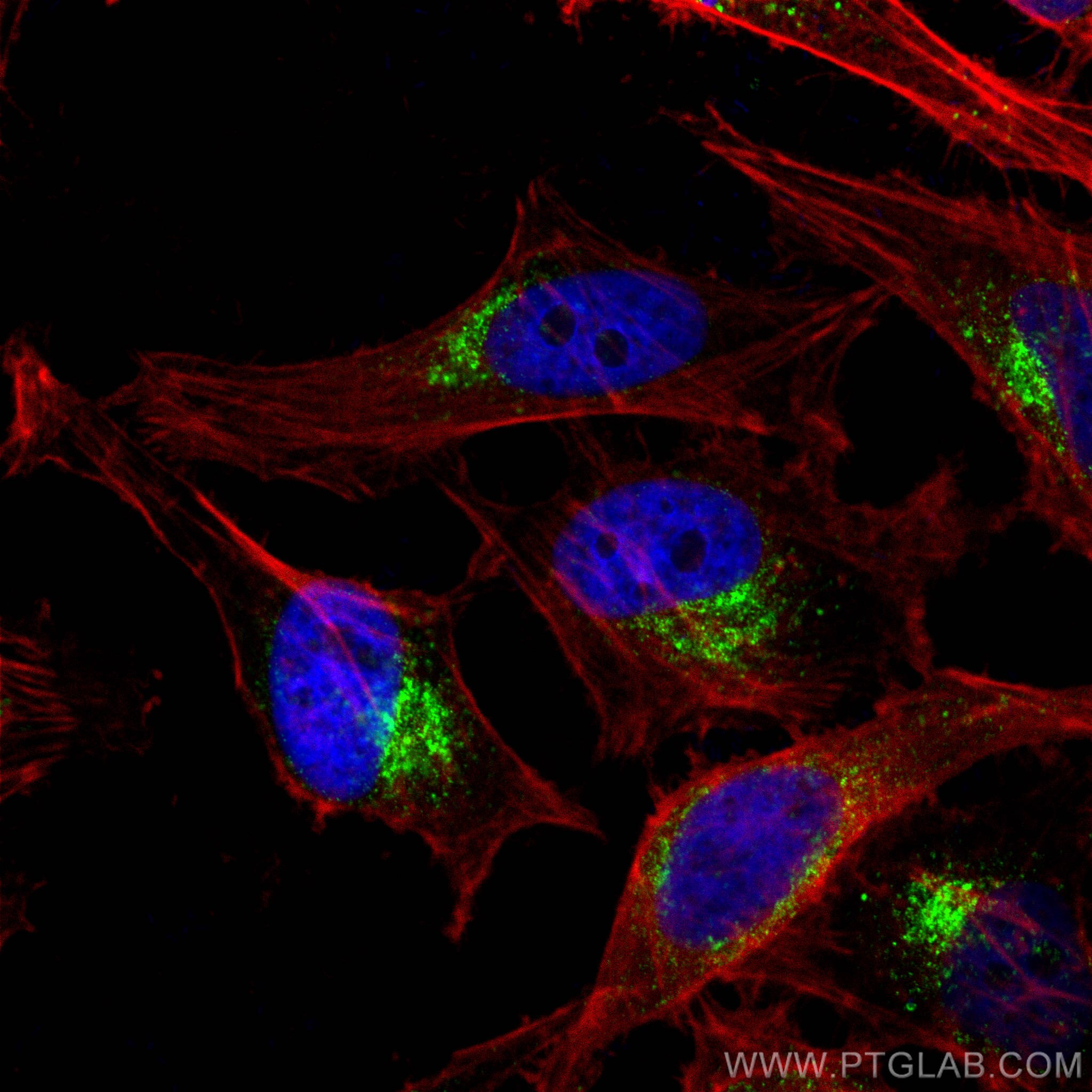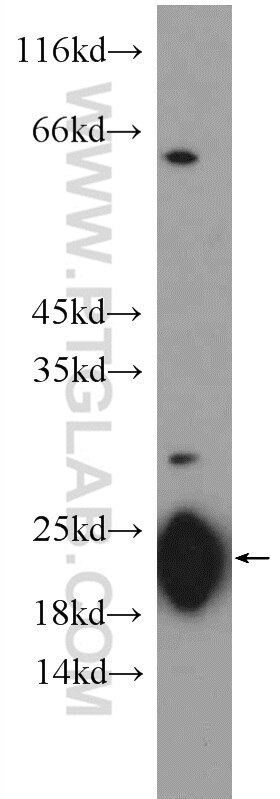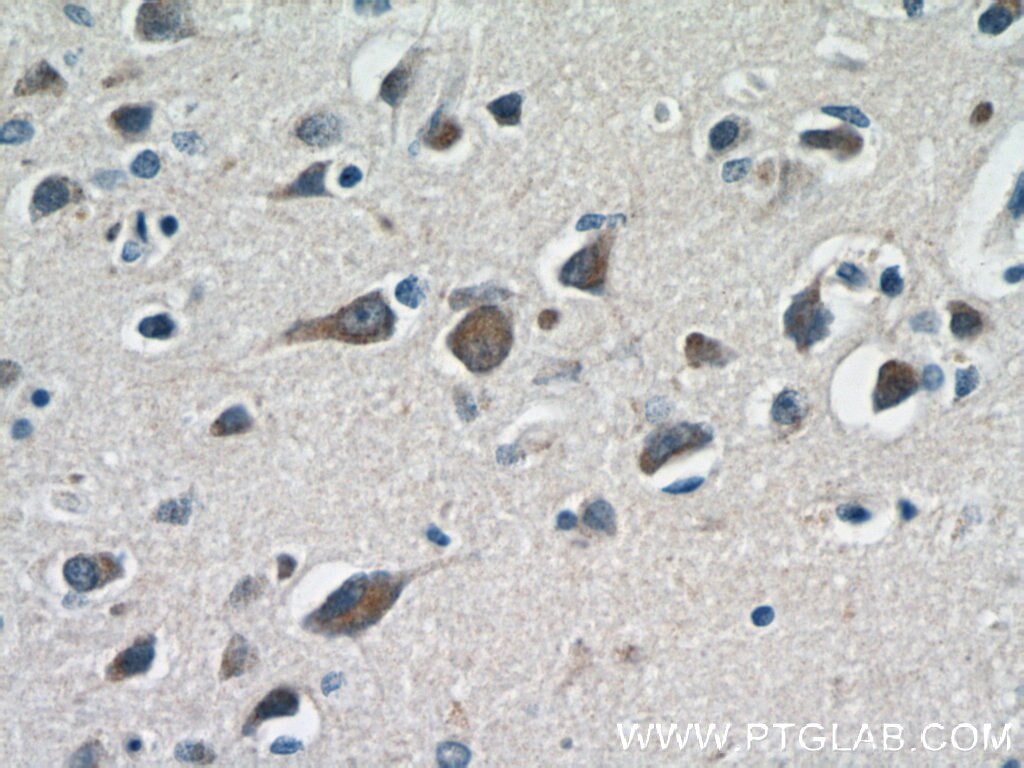- Featured Product
- KD/KO Validated
PSAP Polyklonaler Antikörper
PSAP Polyklonal Antikörper für WB, IHC, IF/ICC, ELISA
Wirt / Isotyp
Kaninchen / IgG
Getestete Reaktivität
human und mehr (4)
Anwendung
WB, IHC, IF/ICC, ELISA
Konjugation
Unkonjugiert
Kat-Nr. : 10801-1-AP
Synonyme
Galerie der Validierungsdaten
Geprüfte Anwendungen
| Erfolgreiche Detektion in WB | A431-Zellen, HeLa-Zellen, HepG2-Zellen, MCF-7-Zellen |
| Erfolgreiche Detektion in IHC | humanes Mammakarzinomgewebe, Maus-Cerebellum-Gewebe, Mausmilzgewebe Hinweis: Antigendemaskierung mit TE-Puffer pH 9,0 empfohlen. (*) Wahlweise kann die Antigendemaskierung auch mit Citratpuffer pH 6,0 erfolgen. |
| Erfolgreiche Detektion in IF/ICC | HeLa-Zellen, HEK-293-Zellen, U-251-Zellen |
Empfohlene Verdünnung
| Anwendung | Verdünnung |
|---|---|
| Western Blot (WB) | WB : 1:1000-1:8000 |
| Immunhistochemie (IHC) | IHC : 1:50-1:500 |
| Immunfluoreszenz (IF)/ICC | IF/ICC : 1:50-1:500 |
| It is recommended that this reagent should be titrated in each testing system to obtain optimal results. | |
| Sample-dependent, check data in validation data gallery | |
Veröffentlichte Anwendungen
| KD/KO | See 2 publications below |
| WB | See 18 publications below |
| IHC | See 2 publications below |
| IF | See 7 publications below |
| ELISA | See 2 publications below |
| FC | See 1 publications below |
Produktinformation
10801-1-AP bindet in WB, IHC, IF/ICC, ELISA PSAP und zeigt Reaktivität mit human
| Getestete Reaktivität | human |
| In Publikationen genannte Reaktivität | human, Huhn, Maus, Ratte, Ziege |
| Wirt / Isotyp | Kaninchen / IgG |
| Klonalität | Polyklonal |
| Typ | Antikörper |
| Immunogen | PSAP fusion protein Ag1194 |
| Vollständiger Name | prosaposin |
| Berechnetes Molekulargewicht | 58 kDa |
| Beobachtetes Molekulargewicht | 60-70 kDa |
| GenBank-Zugangsnummer | BC001503 |
| Gene symbol | PSAP |
| Gene ID (NCBI) | 5660 |
| Konjugation | Unkonjugiert |
| Form | Liquid |
| Reinigungsmethode | Antigen-Affinitätsreinigung |
| Lagerungspuffer | PBS mit 0.02% Natriumazid und 50% Glycerin pH 7.3. |
| Lagerungsbedingungen | Bei -20°C lagern. Nach dem Versand ein Jahr lang stabil Aliquotieren ist bei -20oC Lagerung nicht notwendig. 20ul Größen enthalten 0,1% BSA. |
Hintergrundinformationen
The PSAP gene encodes prosaposin, a precursor of four small nonenzymatic glycoproteins termed 'sphingolipid activator proteins' (SAPs) that assist in the lysosomal hydrolysis of sphingolipids. After proteolytic processing of the presaposin protein, these 4 released polypeptides are functional activators. Saposin A is encoded by residues 60 to 143 of PSAP, saposin B by 195 to 275, saposin C by 311 to 390, and saposin D by 405 to 487. There are four 12-14 kDa heatstable glycoproteins. Saposins A-D localize primarily to the lysosomal compartment where they facilitate the catabolism of glycosphingolipids with short oligosaccharide groups. Saposins A-D are required for the hydrolysis of certain sphingolipids by specific lysosomal hydrolases. (PMID: 2001789) Defects in PSAP are the cause of Gaucher disease, Tay-Sachs disease, and metachromatic leukodystrophy (PubMed: 2060627, PMID: 15773042). This PSAP antibody (10801-1-AP) is expected to recognize both saposin A and B.
Protokolle
| Produktspezifische Protokolle | |
|---|---|
| WB protocol for PSAP antibody 10801-1-AP | Protokoll herunterladen |
| IHC protocol for PSAP antibody 10801-1-AP | Protokoll herunterladen |
| IF protocol for PSAP antibody 10801-1-AP | Protokoll herunterladen |
| Standard-Protokolle | |
|---|---|
| Klicken Sie hier, um unsere Standardprotokolle anzuzeigen |
Publikationen
| Species | Application | Title |
|---|---|---|
Nat Neurosci Genome-wide CRISPRi/a screens in human neurons link lysosomal failure to ferroptosis. | ||
Adv Sci (Weinh) Integrative Transcriptomic Analyses of Hippocampal-Entorhinal System Subfields Identify Key Regulators in Alzheimer's Disease | ||
Nat Commun Prosaposin is a regulator of progranulin levels and oligomerization.
| ||
Nat Commun Impaired prosaposin lysosomal trafficking in frontotemporal lobar degeneration due to progranulin mutations. | ||
Mol Neurodegener Accumulation of saposin in dystrophic neurites is linked to impaired lysosomal functions in Alzheimer's disease brains. | ||
Proc Natl Acad Sci U S A Inhibition of sphingolipid synthesis improves outcomes and survival in GARP mutant wobbler mice, a model of motor neuron degeneration. |
Rezensionen
The reviews below have been submitted by verified Proteintech customers who received an incentive for providing their feedback.
FH Sharan (Verified Customer) (05-28-2020) | The antibody works well in western blot assays with minimum cross-reactivity
 |
FH Krishnendu (Verified Customer) (02-27-2020) | Very specific for AIMP3
|















